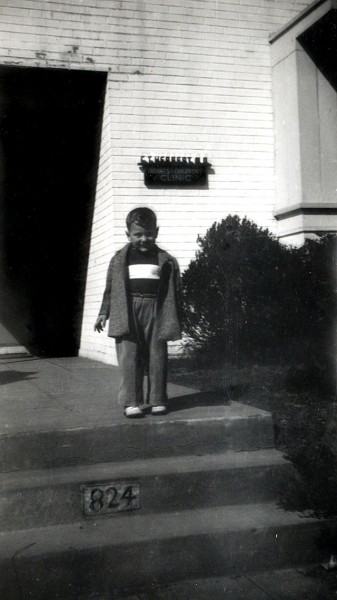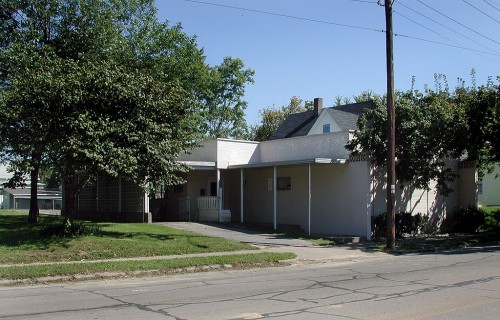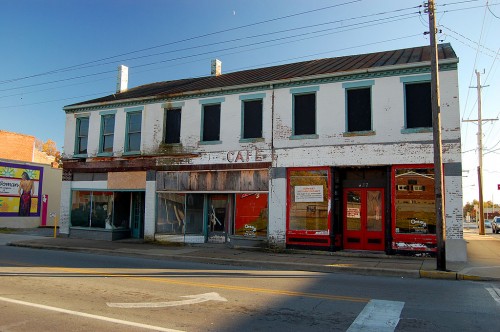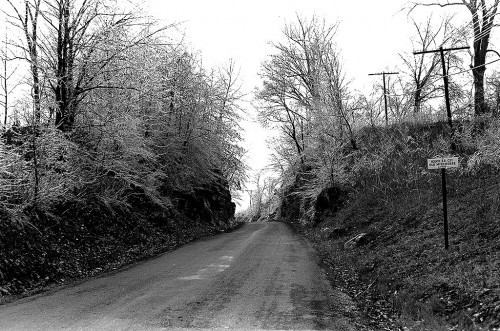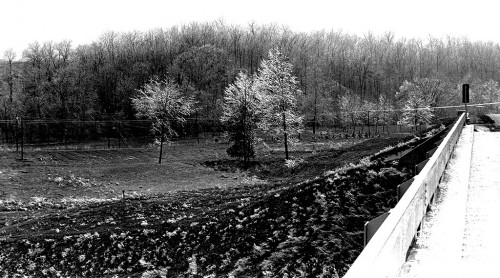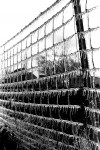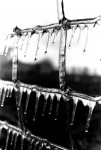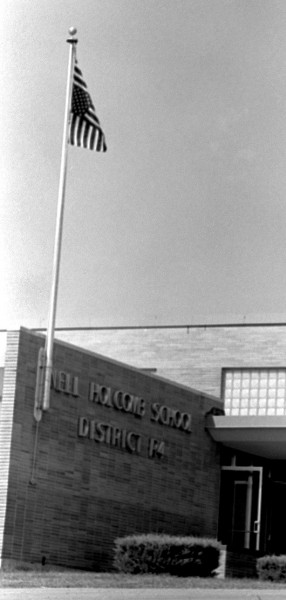Ken Steinhoff in front of Dr. Charles T. Herbert’s office
A little white building that struck fear in my heart
Dr. Charles T. Herbert had an office in a small, white brick building at 824 Good Hope St., directly across from St. Francis Hospital. That was the place where my parents took me for all my vaccinations, school exams, Boy Scout camp physicals and for coughs and sniffles.
I was prone to sore throats, so I’d get hauled off to see Dr. Herbert and his nurse, Miss Mohr, several times a year. [Note: I originally spelled the name Moore, but consensus seems to be building that the correct spelling is Mohr. I’ll make the change, but I’m wishy-washy enough to change it back if the tide turns.]
I’d sit on this table that was covered with something like waxed paper and wait my fate. Eventually, he’d bustle into the room with the scary reflector thing on his head and reach for the tongue depressor.
Open W-I-D-E, here comes the depressor
That tongue depressor was made out of an unsanded 2×4. After about a half an hour of peering this way and that way, making “Uh huh and Hmmmm” sounds, he’d reach into a glass container that looked like a malt glass and extract a 12-foot-long cotton swab that he’d dip into Mercurochrome.
Putting all his weight on the tongue depressor which has been sandpapering my tongue, he’d jam that swab so far down your throat that I thought my toenails would be coated red. Then, he’d work it around like he was churning butter.
To this day, I can’t eat a Popsicle or anything else on a wooden stick. Some folks cringe when they hear fingernails on a chalk board. I don’t know if a tongue can cringe, but that’s what happens when mine is confronted with a wooden stick of any kind. Shivers are going up and down my spine right now just thinking about it.
Out of the Past
There was a note in The Southeast Missourian’s Out of the Past Column on Sept. 3, 2009, that mentioned the office:
25 years ago: Sept. 3, 1984
Dr. John M. Freeze, Cape Girardeau dentist, has purchased one-half of a building at 2857 Independence St., from Dr. Charles T. Herbert, whose offices occupy the other half; Freeze is relocating his office to the new space.
My mother thought that Dr. Herbert moved to Florida after he retired.
Dr. Herbert’s office in 2001
So, what’s the story about Mercurochrome?
It dawned on me that I can’t remember the last time I saw a bottle of Mercurochrome. It used to be a staple in Boy Scout first aid kits for cuts and scrapes. My grandson, Malcolm, is a walking petri dish and a spreader of Plague, but I haven’t heard his parents mention him getting his throat swabbed.
Someone else had asked that very question, “What happened to Mercurochrome?”
You’re dating yourself, pops. Few under age 30 have ever heard of this stuff. In 1998, the U.S. Food and Drug Administration declared that Mercurochrome, generically known as merbromin, was “not generally recognized as safe and effective” as an over-the-counter antiseptic and forbade its sale across state lines. A few traditionalists complained: Whaddya mean, not generally recognized as safe? Moms have been daubing it on their kids’ owies since the Harding administration! But the more reasonable reaction was: It’s about time.
For many years the FDA, faced with the task of regulating thousands of pharmaceuticals and food additives, many of which long predated federal oversight, has maintained the so-called GRAS (generally recognized etc) list, originally compiled as a way of grandfathering in products like Mercurochrome that had been around for ages and hadn’t hurt or killed a noticeable number of people. Recognizing that from a scientific standpoint such a standard left a lot to be desired, the FDA has been whittling away at the unexamined products on the GRAS list over time. Mercurochrome and other drugs containing mercury came up for scrutiny as part of a general review of over-the-counter antiseptics that began in 1978, and for good reason–mercury in large enough doses is a poison that harms the brain, the kidneys, and developing fetuses. While no one’s offered evidence of mass Mercurochrome poisoning, the medical literature contains scattered reports of mercury toxicity due to use of the antiseptic, and these days the burden of proof is on drug manufacturers to show that their products’ benefits outweigh the risks.
I sure wish the FDA had come to that conclusion about 55 years ago and saved me from a lifetime of Popsicle deprivation.

